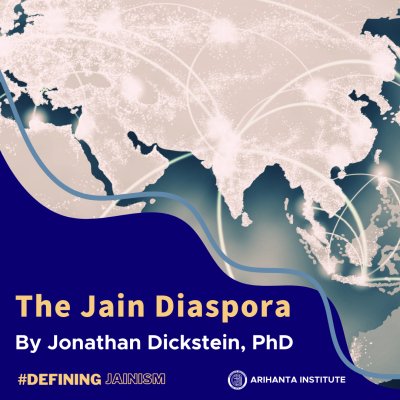The Jain Diaspora

The Jain Diaspora
“Diaspora” is another word for “dispersion.” It refers to the movement and eventual settling of members of a particular religious, ethnic, or cultural community in a location distant from their place of origin. Jain ascetics are traditionally forbidden from permanent relocation and even distant travel, and this fact has contributed to the common popular assumption that Jainism is virtually confined to the Indian subcontinent. However, since the turn of the twentieth century, thousands of lay Jains—and some ascetics as well—have traveled, studied, worked, and eventually established their own thriving communities in Africa, North America, Europe, and elsewhere. Today, out of a global population of approximately 5 to 6 million (official census numbers are most likely low), 250,000 to 300,000 Jains live outside of India, a number that only continues to rise.
The emigration of Jains from India began with British colonization in Asia and Africa. In the nineteenth century, Gujarati Jain traders and other South Asians migrated to Uganda, Kenya, and Tanzania in East Africa. In all likelihood, the first Jain temple outside of India was built in Zanzibar in 1905. In the 1960s, approximately 32,000 Jains lived in Africa, a number that is most likely smaller at present despite a resurgence of migration in recent decades. Following the end of colonial rule and the rise of nationalist movements and policies in Africa, restrictions on foreigners spurred the great majority of the 360,000 South Asians in Africa to leave, including tens of thousands of Jains. The exit occurred immediately in Uganda under the rule of Idi Amin and transpired gradually elsewhere.
This movement out of Africa is critical in understanding the Jain diaspora as many of these South Asians, holding British passports, opted to emigrate to the United Kingdom rather than return to India. By 1968, when the right to automatic entry into the UK was rescinded, approximately 100,000 South Asians had already settled in the UK, including around 15,000 Jains, most with Gujarati ancestry. In the 1970s, of the approximately 20,000 Jains living in the UK, around 75% had not arrived directly from India but rather by way of East Africa. Today, approximately 30,000 Jains live in the UK, predominantly in the greater London area. The second largest European Jain community of around 2,000 resides in Belgium, having been drawn to Antwerp for opportunities in the diamond trade.
“Twice migrants” from East Africa also relocated to the United States and Canada, yet the majority of North American Jains arrived directly from India after the United States implemented (in 1968) the Immigration and Nationality Act of 1965. Prior to this time some Indians—mostly men, as had been the case in the UK—had travelled to the United States and Canada for academic study or professional training, frequently with a long-term plan to return home. By contrast, in the 1970s and increasingly thereafter, many Jains migrated to North America not only with their spouses and children but also with guaranteed employment. After two decades of a new, relatively relaxed immigration policy, approximately 50,000 Jains had rooted themselves in North America, and currently the population is about 150,000 (estimates vary).
North American Jainism is distinguished by its proliferation of a significant number of interconnected Jain centers and institutions. This success is attributable to both the influx of lay Jains since the 1960s and the migration and influence of two notable Śvetāmbara Jain ascetics, Gurudev Chitrabhanu and Acharya Sushil Kumar. Conceived in 1981 and formalized in 1983, JAINA, the Federation of Jain Associations in North America, is “an umbrella organization of 72 Jain centers representing 200,000 members in USA and Canada.” JAINA is the largest organization of Jains outside of India and is guided by a nonsectarian mission to unite Jains in the region and promote Jain values within and outside of the Jain community.
The Jain diaspora is anything but monolithic, and any comprehensive treatment of the topic (see Further Reading) speaks in terms of Jain “diasporas” rather than “the Jain diaspora.” Accordingly, the discussion must also include the Jain communities of the Middle East, East and Southeast Asia, Australia and New Zealand, and elsewhere. Additionally, it highlights variations in gender, class, caste, age, and occupation both between and within these distinct and diverse populations.
Further Reading
Champsee, Lata, Deepika Dalal, and Bijal Mehta, eds. 2015. Jain Digest (May–June). Milpitas: JAINA.
Jain, Prakash C. 2011. Jains in India and Abroad: A Sociological Introduction. Delhi: International School for Jain Studies.
Vekemans, Tine. 2022. Digital & Diaspora: Intertwined Frontiers of Contemporary Jainism. Baden-Baden: Ergon Verlag.
Jonathan Dickstein, Assistant Professor at Arihanta Institute, completed his PhD in Religious Studies at the University of California-Santa Barbara. He specializes in South Asian Religions, Animals and Religion, and Comparative Ethics. His current work focuses on Jainism and contemporary ecological issues, extending into Critical Animal Studies, Food Studies, and Diaspora Studies.
Join Professor Dickstein's course Jainism, Veganism, and Engaged Religion co-taught with Christopher Jain Miller, PhD. 6 hours Self-Study + Live Q&A zoom sessions will take place on June 7, 14, 21, and 28 from 8AM to 9AM Pacific and will be recorded for later viewing.
Check out all Arihanta Institute courses here:
